






InUrSkn is more than just a skin a hair and body clinic. It is Dr. Sejal's promise of providing minimal intervention patient care which is holistic, personalized and humane.












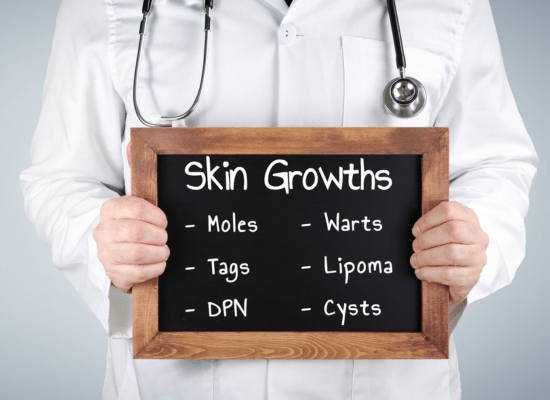
Moles, or nevi, are common skin growths that often appear as small, dark spots caused by clustered melanocytes. While they are typically harmless, rare cases can become cancerous. Moles can develop anywhere on the body and may change or fade over time, particularly during hormonal changes such as adolescence or pregnancy. Although benign moles require no treatment, they can be removed—if desired—through methods like surgical excision, cryotherapy, or laser treatment. Moles often run in families and may increase during major life transitions.
Read More
Skin tags, medically termed acrochordons, are benign skin growths commonly found in body folds such as the neck, underarms, and groin. Primarily a cosmetic concern, they are often removed for aesthetic reasons. While they can run in families, their occurrence may increase with significant weight gain, obesity, or hormonal changes such as those during pregnancy. Managing body weight and blood sugar levels in diabetics can help control their formation. Removal is simple and can be performed through dermatological surgical methods such as cryotherapy or laser excision.
Read More
Dermatosis Papulosa Nigra (DPN) is a common condition among individuals with darker skin tones, characterized by the appearance of small, dark papules primarily on the face, neck, and upper torso. Although benign, the number and size of these papules tend to increase with age. Effective treatments include simple dermatological procedures such as excision, cryotherapy, or laser removal to manage or eliminate these skin formations.
Read More
Warts, caused by the Human Papillomavirus (HPV), are rough growths on the skin that often appear greyer than the surrounding area. They are contagious and come in various types, including common, plantar, flat, filiform, and periungual warts. Prompt treatment is essential. Genital warts, linked to certain HPV strains, carry a risk of cancer. Prevention includes practicing safe sex and receiving the HPV vaccine. Treatment options range from topical antivirals to minor surgical excision.
Read More
Lipomas are benign growths of fatty tissue that develop between the skin and the underlying muscles. They are characterized by a soft, rubbery texture and most commonly appear after the age of 30. While generally harmless, lipomas are often a cosmetic concern and typically occur on the back, torso, arms, shoulders, and neck. Ranging in size from 1 to 6 inches, they are usually treated for aesthetic reasons through a straightforward dermatological procedure.
Read More
Sebaceous cysts are benign growths under the skin filled with sebum and typically originate from sebaceous glands. They appear as whitish or yellowish bumps and can occur anywhere on the body—except the palms and soles, where sebaceous glands are absent. While they are usually not painful, they may become tender or sore if infected. Treatment, often sought for cosmetic reasons, involves dermatosurgical excision using methods such as scalpel surgery or CO₂ laser excision.
Read More

Skin growths are primarily treated through a minor surgical procedure called excision. It is a simple procedure that can be performed in the clinic and typically does not require any recovery time.
InUrSkn offers world-class infrastructure and technology to carry out such procedures. At InUrSkn, we ensure that hygiene and safety are paramount, leaving nothing to chance.
In addition, Dr. Sejal personally performs every medical procedure, ensuring the best possible results.
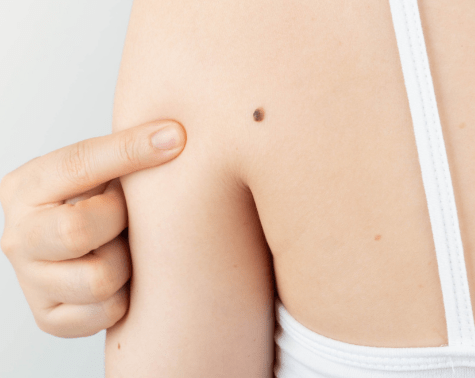
Moles (nevi) are a common type of skin growth. They often appear as small, dark brown or black spots and are caused by clusters of pigment-forming cells (melanocytes). Most moles are harmless; rarely, they can become cancerous.
Moles can develop anywhere on the body, including the scalp, armpits, under the nails, and between the fingers and toes. Most people have between 10 and 40 moles, many of which develop by the age of 50. Moles may change or fade over time. With hormonal changes during adolescence and pregnancy, they may become darker and larger.
There are three basic types of moles: regular and symmetrical, irregular, and cancerous. Most benign moles are about the size of a pencil eraser and can be either flat or raised with well-defined edges.
The primary cause of moles is genetic—they tend to run in families. Moles can also increase in number during pregnancy, puberty, and other transitional life stages.
Benign moles typically do not require treatment. However, they can be removed through simple excision procedures. Common removal methods include:
Yes, sun exposure can lead to the development of new moles by triggering melanocytes to produce pigment.
Yes, dermatologists can perform mole screenings to identify abnormal or potentially cancerous moles.
Yes, besides color variations, moles can be categorized based on their shapes, such as regular, irregular, and potentially cancerous.
Irregular moles may have uneven colors or undefined edges and could indicate a higher risk for skin cancer, warranting a medical evaluation.
Yes, mole removal for cosmetic reasons is generally safe when performed by a qualified healthcare professional.
Other than surgical excision, methods like cryotherapy and laser excision are non-surgical options for mole removal.
Though rare, moles can potentially reoccur at the same spot after removal.
The number of moles can stabilize or decrease with age, but new moles appearing after age 30 should be checked by a dermatologist.
Home remedies for mole removal are not recommended as they can cause scarring or infection, and potentially overlook a cancerous mole.
Healing time post mole removal varies among individuals, generally taking a few weeks. It’s advisable to follow post-care instructions for quicker recovery.
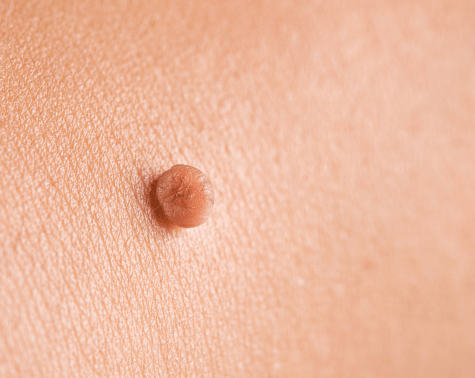
Skin tags are extra growths of normal skin that are benign in nature. They typically form in areas where the skin folds, such as the neck, underarms, groin, eyelids, and beneath the breasts, and occasionally on flat areas like the face. Medically, they are known as acrochordons.
These tags appear as small nubs, and when they enlarge, they often develop a stalk with a larger head. Most skin tags range in size from 1 to 5 mm, and only rarely do they grow larger.
Since skin tags are benign, they are primarily a cosmetic concern, and treatment is usually sought only if a person is bothered by their appearance.
Skin tags are often hereditary, but they can also form due to significant weight gain. They are more common in individuals with obesity compared to those with a lower BMI. A sudden increase in skin tags may occur during pregnancy, due to a rise in growth factors in the body.
The best way to prevent the formation of skin tags is to maintain a healthy body weight. For those with diabetes, controlling blood sugar levels may help reduce the formation of new tags.
The most effective way to remove skin tags is through a simple dermatological procedure called excision, which can be performed using one of the following methods:
No, skin tags are not contagious.
Usually, skin tags are painless, unless irritated by clothing or jewelry.
Yes, it’s possible though not common for skin tags to reappear after removal.
No, they typically don’t indicate any underlying medical conditions.
No, skin tags are benign and don’t turn cancerous.
There’s no foolproof way to prevent skin tags, though maintaining a healthy weight may help.
It’s advisable to consult with a dermatologist before using over-the-counter solutions for skin tag removal.
Yes, skin tags tend to occur more often as people age.
Some natural remedies are purported for skin tag removal, but it’s best to consult with a healthcare professional for safe and effective treatment.
Yes, if a skin tag is repeatedly irritated or scratched, it could potentially become infected.
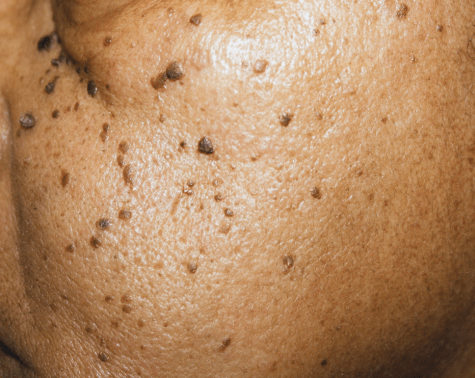
DPN stands for Dermatosis Papulosa Nigra. It is a common skin condition seen in individuals with darker skin tones. This condition is characterized by the appearance of multiple small, dark-colored papules on the face. These papules are benign and do not pose any health threat. They typically develop on the face, neck, and upper torso, and usually measure between 1 to 5 mm in diameter and 1 to 3 mm in height. Their number and size tend to increase with age.
DPN is often considered a variant of another common benign skin condition called seborrheic keratosis. It is largely familial in nature but may be aggravated by sun exposure. It is also commonly seen in individuals with darker skin who use skin-lightening treatments. However, the exact cause of DPN remains unknown.
Limiting sun exposure is currently the only known preventive measure for DPN.
The most effective treatment for DPN is a simple dermatological procedure called excision. The excision can be performed using the following methods:
DPN primarily affects dark-skinned individuals and often appears as dark papules on the face, whereas moles can occur on anyone and anywhere on the body.
Results post-treatment can be noticed immediately or within a few weeks depending on the method used for removal.
No, DPN is benign and does not lead to skin cancer. However, any changes in skin growths should be evaluated by a healthcare professional.
There’s no guaranteed method to prevent DPN recurrence, though limiting sun exposure can be beneficial.
Scarring post DPN papule removal varies among individuals and the method used; consulting a dermatologist for the most suitable method is advisable.
Currently, there are no creams proven to effectively treat DPN. Surgical excision methods are the most reliable treatments.
Home remedies are not recommended for treating DPN as they may cause adverse reactions or infections. Professional medical treatment is advisable.
No, DPN is not contagious as it’s a benign skin condition.
Complications are rare but may include infection, scarring, or pigmentary changes, hence, post-operative care is crucial.
DPN primarily occurs on the face, neck, and upper torso but might appear elsewhere, albeit rarely.
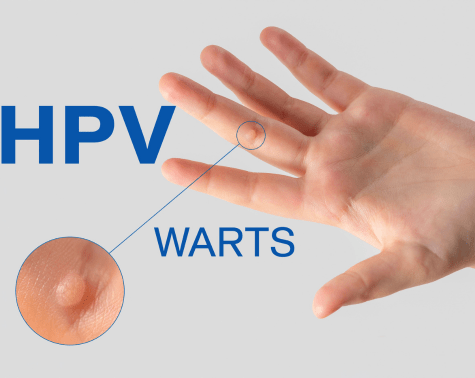
Warts are raised growths on the skin caused by HPV (Human Papillomavirus). Since they are viral in nature, warts are contagious and should be treated promptly to prevent their spread—both on the patient’s body and to others.
Warts are often unpleasant in appearance due to their rough, thick, and grainy texture. They are usually greyish in color, contrasting with the surrounding healthy skin.
Warts are classified based on their growth pattern and the body region they affect. Common types include:
Genital Warts are caused by certain high-risk types of the HPV virus. These can be painful and dangerous—some strains may even lead to cancer.
It is crucial for patients to seek medical attention promptly for any type of wart.
Prevention of HPV includes the use of condoms and the practice of safe sex.
Additionally, an HPV vaccine is available. It provides protection against nine strains of HPV, including those linked to genital warts and HPV-related cancers.
Warts are often treated with topical antivirals or acid-based treatments. If these are ineffective, the next step is minor surgical excision, which can be performed using the following methods:
Yes, warts are caused by HPV and are contagious, easily spread through skin-to-skin contact.
Warts have a rough, grainy texture and are often greyish in color. If unsure, consult a dermatologist.
Yes, warts can spread to other areas of the body if touched or scratched.
Yes, warts can recur after treatment as HPV may remain in the skin.
Over-the-counter treatments may be effective for some, but it’s advisable to consult a healthcare provider for persistent or painful warts.
It varies; warts may disappear within weeks post-treatment or might take longer.
Home removal, especially cutting or burning, is not recommended and can cause infection. Professional medical treatment is advisable.
Certain types of HPV, especially those causing genital warts, can potentially lead to cancer, making prompt treatment essential.
Warts can affect individuals of all ages, but children and teenagers are often more susceptible.
Avoiding skin-to-skin contact, not sharing personal items, and keeping warts covered can help prevent spreading warts to others.
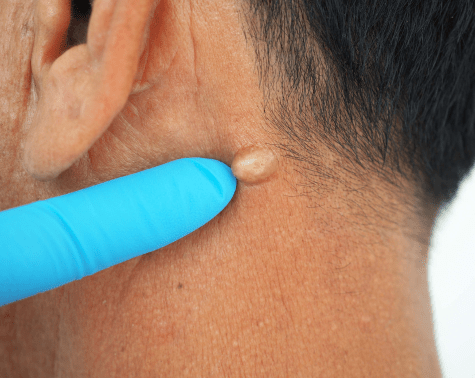
A lipoma is a soft lump of fat that develops between the skin and muscles. Lipomas have a rubbery feel and can move easily when pressed with a finger. Most lipomas are benign and require treatment primarily for cosmetic reasons. They most commonly appear on the back, torso, arms, shoulders, and neck.
Lipomas typically occur after the age of 30. They do not spread to other parts of the body and are generally painless. Compared to most skin lesions, lipomas are relatively large, ranging between 1 and 6 inches in size.
Lipomas are idiopathic, meaning their exact cause is unknown. However, they are known to be familial in nature. The different types of lipomas are as follows:
Lipomas can be removed through a simple dermatological surgical procedure.
They may be linked to certain hereditary conditions like familial multiple lipomatosis.
Yes, though uncommon, lipomas can reoccur in the same area after removal.
Exercise doesn’t directly affect lipomas as they consist of fatty tissue, not excess body fat.
There’s no proven dietary change to prevent or reduce lipomas, though a healthy diet is always beneficial.
Some suggest liposuction or steroid injections, but effectiveness varies and surgical removal is most common.
Usually painless, though angiolipomas can be painful due to their vascular nature.
Lipomas can slowly grow over time, but they usually remain the same size once formed.
They are soft and rubbery to touch, moving easily when pressed.
It’s extremely rare, but lipomas can become a cancerous tumor called a liposarcoma.
Follow your doctor’s instructions, keeping the area clean to avoid infection and attending follow-up appointments.
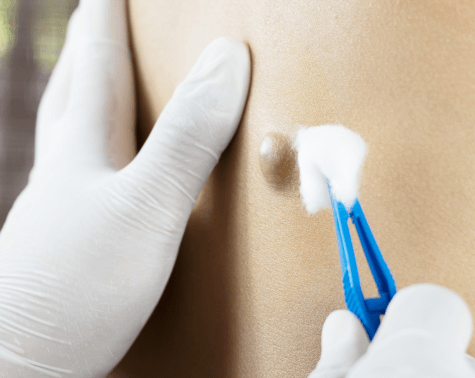
Sebaceous cysts are whitish or yellowish-colored growths under the skin. These cysts do not contain pus; instead, they are primarily filled with sebum. This is because sebaceous cysts typically originate around sebaceous glands and gradually increase in size.
Sebaceous cysts are benign in nature and can occur on nearly every part of the body—except the palms and soles, as these areas lack sebaceous glands. Sebaceous glands are responsible for producing sebum, a fluid composed mainly of lipids (fats) and some proteins.
Sebaceous cysts are generally not painful unless they become infected. In such cases, they may appear reddish and tender. When pinched or squeezed, sebum may ooze out of the cyst. These cysts can occur at any age and often require treatment for aesthetic reasons.
They typically form due to issues with a sebaceous gland, such as blockage or damage. Certain medical conditions can also lead to their development.
The best way to treat a sebaceous cyst is through a simple dermatological procedure called excision. This can be performed using one of the following methods:
Some may diminish or vanish over time, but many remain unchanged or may grow.
Pimples are inflammations of skin pores while sebaceous cysts are blocked sebaceous glands filled with sebum.
It’s extremely rare but not impossible; any sudden growth or change should be evaluated.
Common triggers include gland blockage, trauma, or certain medical conditions.
No, squeezing can lead to infection or exacerbate the cyst.
Through physical examination, and sometimes imaging tests or a biopsy.
Yes, especially if they’re infected or if they’re removed without proper care.
Keeping the skin clean can help, but there’s no foolproof prevention due to their often idiopathic nature.
No significant gender bias exists, they can occur in both males and females.
They can vary greatly in size, from a few millimeters to several centimeters.


MD, DNB - Dermatology & Venereology
Dr. Sejal has dual degrees of MD and DNB in Dermatology and Venereology. She has worked with some of the senior most doctors in the largest government and private hospitals for more than 15 years. Over these years at InUrSKn, she has treated thousands of patients for a variety of conditions and needs across dermatology, venereology, cosmetology and trichology domains.
Dr. Sejal believes in a minimum intervention approach to health and believes that educating and empowering the patient is the key to good health.
Every patient at InUrSkn is seen personally by Dr. Sejal without any time limit, where she discusses the patient’s concern in detail along with understanding the history of their health and carrying out a personal examination.
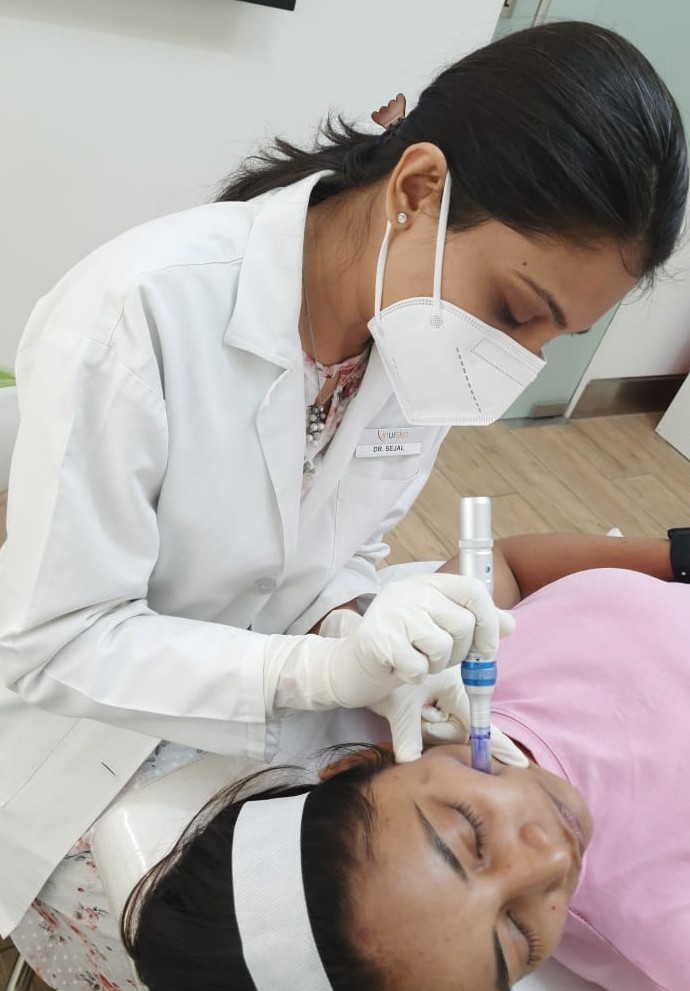
At InUrSkn we belive that all patient care must be
– Holistic
– Personalized
– Humane
– Minimal
That is Dr. Sejal and Team live by the philospohy to never prescribe medications or procedures that may not be required and while approaching a concern Dr. Sejal ensures that a detailed history and context is understood by her. Medical tests are prescribed by Dr. Sejal when she believes that there is more to the concern which needs to be addressed and only then the patient can truly benefit.
Multiple spacious procedure rooms
Full-fledged operation theatre
In-house laboratory
Latest technology
100+ Skin, Hair & Body Procedures offered
Frequent disinfection of all clinic spaces with UVC light and WHO-approved chemicals
Large waiting and treatment areas to ensure social distancing
Regular health checks for all patients and staff
Safer than salons, chain-clinics & hospitals
PPEs for patients and staff
Personal attention from Dr. Sejal Saheta (MD, DNB) - with 15+ years of experience
CIDESCO-certified aestheticians with minimum 3 years work experience
500+ Positive Reviews on Practo and Google
5000+ Patients treated last year alone
8000+ Procedures completed
| Prices | ||
|---|---|---|
| Procedure | ||
| In Clinic Consultation with Dr. Sejal | ||
| In Clinic Consultation with Dr. Sejal | ₹1200 | |
| Online Consultation with Dr. Sejal | ||
| Online Consultation with Dr. Sejal | ₹1000 | |
Pricing (Inclusive of taxes)


Genetics, age, sun exposure, and certain health conditions can contribute to skin growths.
Yes, as people age, the likelihood of developing skin growths often increases.
Benign growths are generally consistent in color and border, while malignant ones may have irregular borders and color variations. It’s crucial to get a professional diagnosis.
Yes, chronic irritation or allergic reactions can sometimes lead to skin growths.
Yes, prolonged sun exposure can increase the risk of various skin growths, including cancerous ones.
It depends on the type. For instance, warts are contagious, but most other skin growths are not.
It’s possible, especially if the underlying cause isn’t addressed.
Some growths may respond to topical treatments, but it’s essential to consult with a dermatologist.
Yes, a balanced diet, staying hydrated, and maintaining a healthy lifestyle can support skin health.
Dermatologists are specialists in treating skin conditions including skin growths.
While some suggest home remedies, it’s always safer to consult a dermatologist before attempting self-treatment.
It varies; treatments for medical reasons are often covered, but cosmetic procedures may not be.
Protecting skin from the sun, maintaining a healthy lifestyle, and regular skin checks can help reduce risk.
A biopsy can provide a definitive diagnosis, especially when malignancy is a concern.
Yes, skin growths can occur in individuals of all skin types, though some types may be more prone to specific growths.


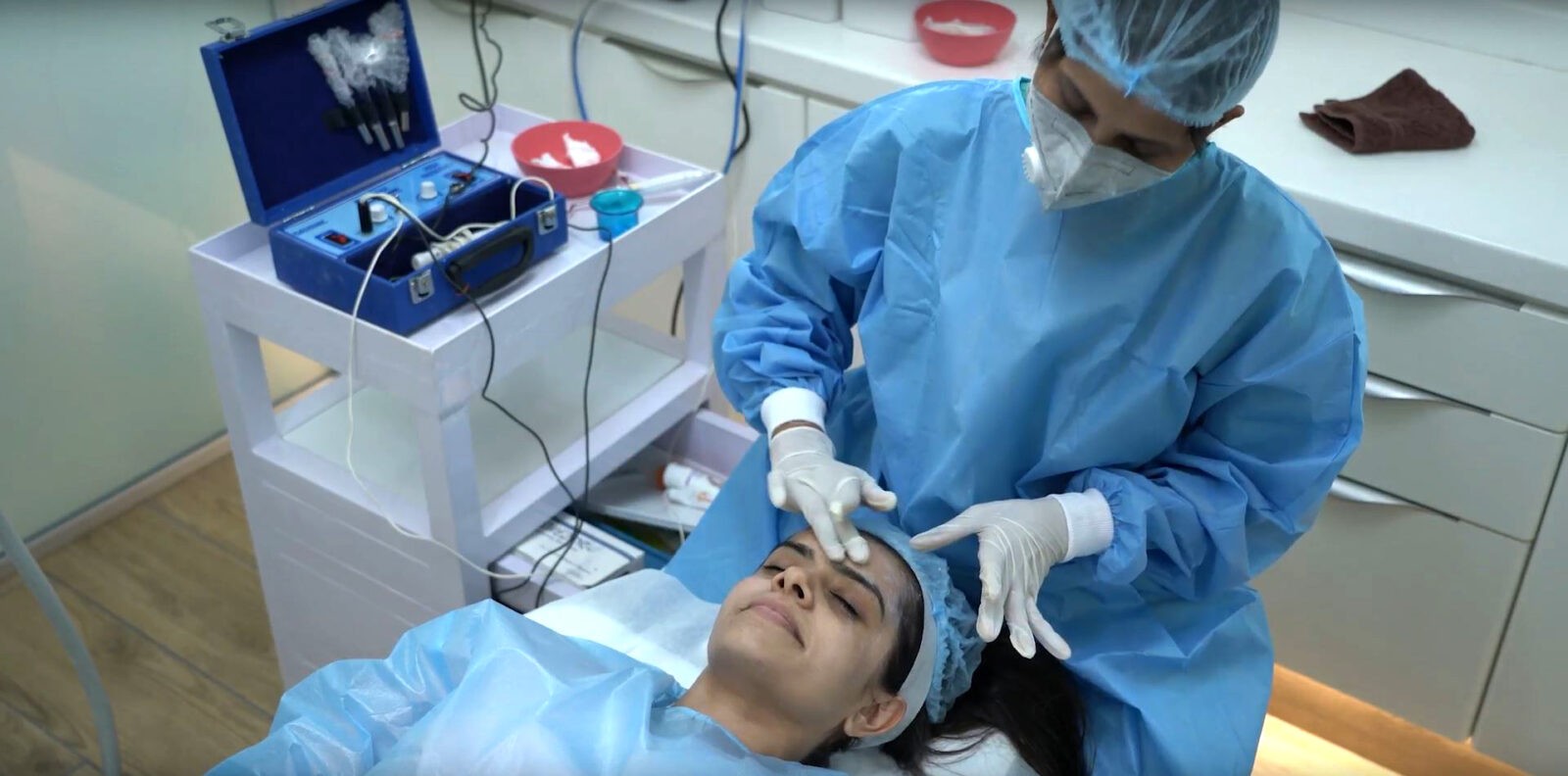
Ready to book an appointment?
BOOK
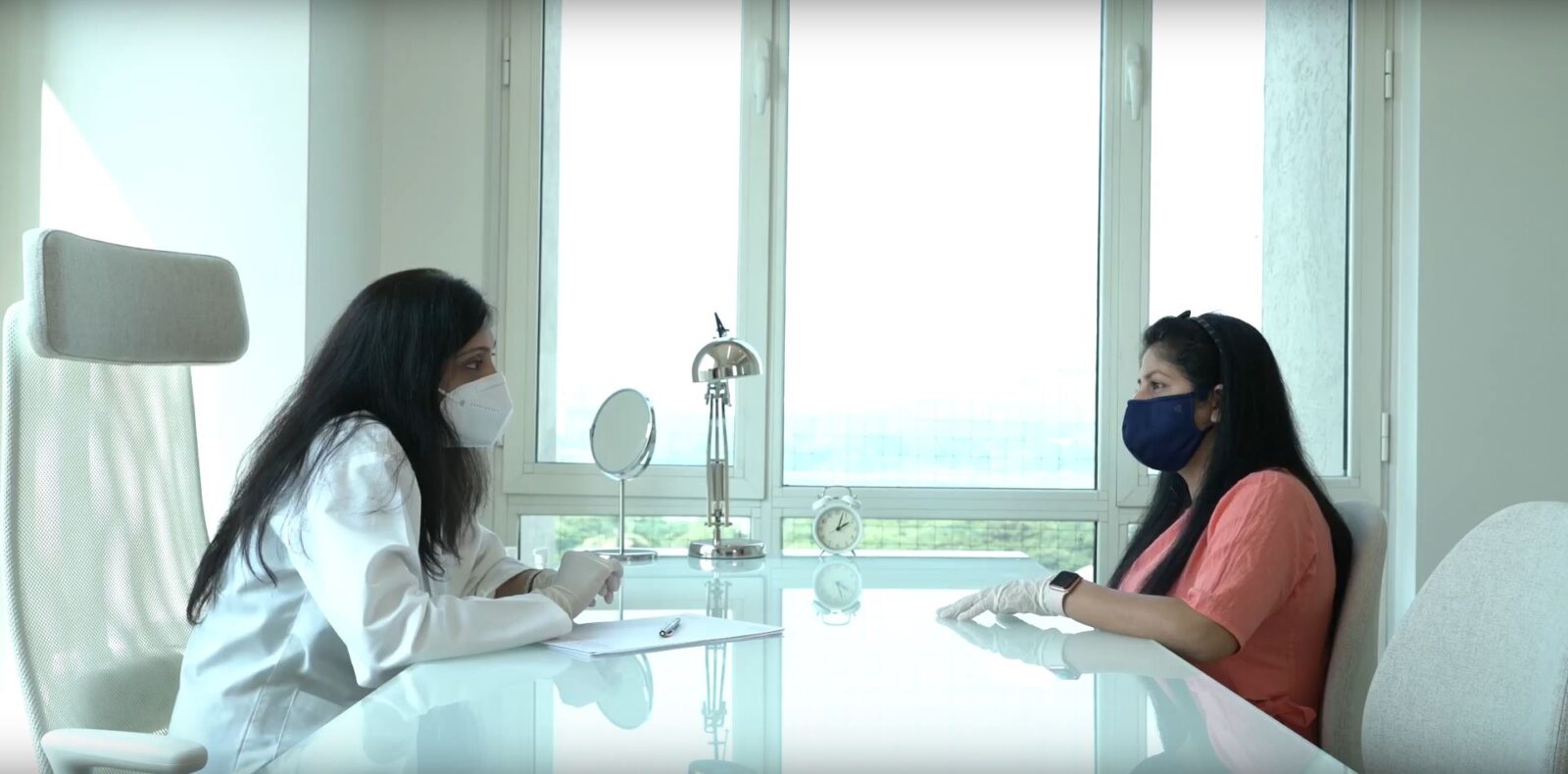
Want to talk about your needs ?
MAKE AN enquiry
